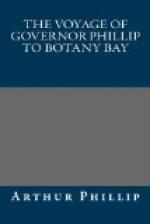It was understood from the natives that they called the island from which they came, Simboo; for whenever an attempt was made to put that question to them, they pointed to the land near Cape Satisfaction, and uttered that word. Of these men, Lieutenant Shortland remarks, that they were remarkably stout and well built, from which appearance he very judiciously drew a favourable conclusion with respect to the goodness and plenty of their food. Their superiority over the New Hollanders in size and strength, he says, was very striking. Their canoes, which contained from six to fourteen men, seemed to be well put together, the bows and stems very lofty, carved with various figures, and stained with a kind of red paint; in a word, they were to all appearance formed exactly upon the same model and construction as those of Otaheite. The ornaments worn by the inhabitants of Simboo were large rings of a white bone, one or more of which every man had upon his wrist, and a shell with a feather, which was tied upon the head. Lieutenant Shortland was desirous to purchase one of their lances, but could not obtain it. About two in the afternoon his visitors, finding perhaps that they had followed the ship as far as they could venture to trust themselves, left him, and made immediately for the shore. From what was seen in the possession of these people, there can be no doubt that their land produces cocoa-nuts, bread-fruit, bananas, and most other vegetables of the Society and Friendly Isles. Nor was it without the greatest regret that Lieutenant Shortland declined the invitations of the natives, and proceeded without touching for refreshments, which doubtless might have been obtained in plenty; but the length and uncertainty of his passage seemed to forbid the least delay; nor was it at this time foreseen how much superior to every other consideration the acquirement of a wholesome change of diet would be found. The bay from which these men had come he named Indian Bay. At three P. M. the longitude was, by lunar observation, 156 deg. 55’ east; and at six the furthest land in sight bore north, Cape Satisfaction east by south half east, and the body of the land north-east, distant five or six leagues. The furthest point of land north was named Cape Middleton.
7 August 1788
After lying to in the night, the ships made sail again at four in the morning of August 7th, and bore away to the north by west. At five, they saw the land which they had left the preceding night, and six or more small islands bearing from north-east to west. These were called the Treasury Isles; they are moderately high and seemed to be well clothed with trees and herbage. At noon, the latitude was by observation 7 deg. 24’ south, the longitude 156 deg. 30’ east; and the north-west extremity of the land then in sight, which was named Cape Allen, bore east by south, distant six leagues: Cape Middleton, south-east, distant eight leagues. Off Cape Allen lies a small island, to which the name of Wallis Island was given. At six in the afternoon the extremes of the islands in sight bore from north-east by east to west by north; and the entrance between two islands, which formed a passage or strait, bore north by east, distant five or six leagues.




